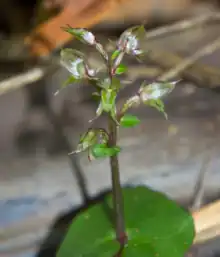| Pixie caps | |
|---|---|
 | |
| In Kaimai Mamaku Conservation Park, New Zealand | |
| Scientific classification | |
| Kingdom: | Plantae |
| Clade: | Tracheophytes |
| Clade: | Angiosperms |
| Clade: | Monocots |
| Order: | Asparagales |
| Family: | Orchidaceae |
| Subfamily: | Orchidoideae |
| Tribe: | Diurideae |
| Genus: | Acianthus |
| Species: | A. sinclairii |
| Binomial name | |
| Acianthus sinclairii | |
| Synonyms[1] | |
|
Acianthus fornicatus var. sinclairii (Hook.f.) Hatch | |
Acianthus sinclairii, commonly known as pixie cap or heart-leaf orchid, is a flowering plant in the orchid family Orchidaceae and is endemic to New Zealand. It is a terrestrial herb with a single, heart-shaped leaf and up to ten translucent green flowers, usually tinged maroon.
Description
Acianthus sinclairii is a terrestrial, perennial, deciduous, sympodial herb with a single heart-shaped, glabrous, dark green leaf which often has a maroon tinge or markings. The leaf is 10–30 mm (0.4–1 in) long, one-quarter to halfway up the slender stem, which is about 100 mm (4 in) long at flowering but increases later.[2][3][4]
There are up to ten flowers, 6–8 mm (0.2–0.3 in) long, green but with purple blotches and a dull red labellum. The dorsal sepal is broadly lance-shaped to egg-shaped and forms a hood over the column. The lateral sepals are similar in length to the dorsal sepal but have a pointed end and face forward beneath the labellum. The petals are somewhat shorter than the sepals, are lance-shaped and spread widely. The labellum is also shorter than the sepals, dished, broadly egg-shaped with the edges turned under, dull red with two rounded calli at its base. Flowering occurs between January and October.[2][3][4]
Taxonomy and naming
Acianthus sinclairii was first formally described in 1853 by Joseph Dalton Hooker and the description was published in The Botany of the Antarctic Voyage of H.M. Discovery Ships Erebus and Terror in the years 1839–1843, under the Command of Captain Sir James Clark Ross.[5] Hooker noted that this species is similar to Acianthus fornicatus "but differs in the lip [labellum] being less glandular". The specific epithet (sinclairii) honours Andrew Sinclair, a Scottish botanist and friend of Hooker.[6]
Distribution and habitat
This orchid usually grows in shaded shrubland and forest, only rarely in sunny habitat but often near streams or moist areas. It occurs on both the North Island and South Island as well as on Stewart and Chatham Islands and on Raoul Island in the Kermadec Group.[3]
Conservation
Acianthus sinclairii is common and classified as "not threatened".[2]
References
- 1 2 "Acianthus sinclairii". Plants of the World Online. Retrieved 6 March 2023.
- 1 2 3 "Acianthus sinclairii". New Zealand Native Orchid Group. Retrieved 18 June 2016.
- 1 2 3 "Acianthus sinclairii". New Zealand Plant Conservation Network. Retrieved 18 June 2016.
- 1 2 "Acianthus sinclairii". Flora of New Zealand. Retrieved 18 June 2016.
- ↑ "Acianthus sinclairii". International Plant Names Index (IPNI). Royal Botanic Gardens, Kew; Harvard University Herbaria & Libraries; Australian National Botanic Gardens. Retrieved 18 June 2016.
- ↑ Hooker, Joseph Dalton (1853). The Botany of the Antarctic Voyage of H.M. Discovery Ships Erebus and Terror in the years 1839–1843, under the Command of Captain Sir James Clark Ross. London: Lovell Reeve. p. 245. Retrieved 18 June 2016.
External links
 Media related to Acianthus sinclairii at Wikimedia Commons
Media related to Acianthus sinclairii at Wikimedia Commons